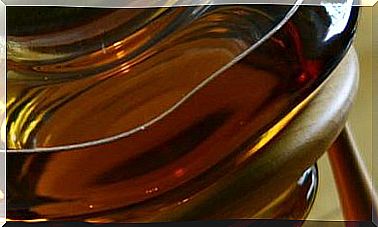Anti-inflammatory Menus: Ideal Breakfast, Lunch And Dinner
Mild processes of chronic inflammation can be fought by including certain anti-inflammatory foods in the menus and eliminating those that inflame. What should an anti-inflammatory breakfast, lunch or dinner be like?

- Anti-inflammatory foods
- Inflammatory foods
- The ideal anti-inflammatory breakfast
- Anti-inflammatory food menu
- Anti-inflammatory dinner menu
- Sauces for anti-inflammatory menus
Anti-inflammatory menus should include mostly fruits and vegetables, whole grains, plant proteins such as legumes and nuts, spices and fresh aromatic herbs.
The quality of the fats that we consume is of vital importance to control inflammation, since those that are manipulated or modified stimulate pro-inflammatory prostaglandins. Unprocessed natural oils are the healthy alternative, but as long as we eliminate harmful fats from our diet, especially those modified from trans configuration.
It is not so much about banning certain foods but that, if consumed, they constitute a very insignificant part of the diet. If you have a chronic disease, you have to be much more careful. But if the body is fit, it can combat mild, chronic low-grade inflammation processes and maintain balance. How to achieve anti-inflammatory breakfast, lunch and dinner menus? We are going to show you the keys to preparing your own anti-inflammatory menus.
What foods have anti-inflammatory properties?
- Fruits: cherries, currants, blueberries, blackberries, grapes (better if they are black and eaten with their skin), berries and berries.
- Healthy Fats: Virgin cold pressed olive, flax, walnut or sesame oils .
- Nuts: pine nuts, walnuts, almonds, sesame, chia or wheat germ, due to its richness in good biological quality fats and its excellent protein.
- Avocado. Contains up to 15% fat rich in oleic, palmitic and linoleic acid, of excellent quality. But be careful, because it is a very caloric food.
- Broccoli, kale, and cabbage. They contain vitamin K, indoles and isothiocyanates with anti-inflammatory and detoxifying properties.
- Papaya and tropical pineapple. They contain proteases such as papain and bromelain, which exert anti-inflammatory action. In the form of dried fruit they are also interesting.
- Green Tea. Contains polyphenols and catechins with antioxidant action. Without sugar and without milk, it is a very healthy drink, especially when compared to a coffee with milk, for example.
- Shiitake and mushrooms in general. Some mushrooms are marketed in pharmaceutical form as anti-inflammatory. They are excellent for preventing low-grade inflammation. The shiitake mushroom is possibly the best known, but mushrooms, chanterelles or chanterelles are also anti-inflammatory.
- Spices: turmeric, ginger, cloves … You can add them to your rice dishes and soups to give them an exotic and healthy touch.
- Tomato. It is very rich in lycopene, a powerful fat-soluble antioxidant. For this reason, cooking tomatoes, for example in the form of tomato sauce, improves the activity of lycopene. Tomato juice (plain, not canned) can also be anti-inflammatory.
- Cocoa. The flavanols in cocoa protect the endothelium, the thin inner layer of the arteries, from inflammation, which improves cardiovascular health. We are talking about pure cocoa, not milk chocolate. A chocolate with more than 70% cocoa has quite a lot of flavanols, but the other 30% also counts. Avoid sweeteners and refined fats.
What are the foods that cause the most inflammation?
- Sugar. It is an energy pump devoid of other nutrients. Its high calorie content makes it unsuitable for metabolic diseases and induces low-grade cellular inflammation. Avoid any product with added sugar.
- Refined or highly refined flours such as cookies, pastries, crustless white bread, etc. They are foods with a very high glycemic index, which are more like sugar than unrefined carbohydrates. They give a lot of energy and therefore have a certain addictive power.
- Foods with trans fats (margarinized). They are manipulated fats, notably pro-inflammatory. French fries, pastries, margarines, prepared sauces, pizzas, snacks, milk creams for coffee … they can contain them in high quantities.
- Ice creams. The industrialists carry fats and other elements of very little interest to health. They are also pro-inflammatory.
- Ultra-processed foods, to which colorants, flavoring agents, preservatives or other additives have been added. Fast food dishes, frozen preparations and processed meats have been linked to an increase in C-reactive protein, linked to inflammatory processes.
- Fried in general, especially if we do not fry them ourselves, as we cannot guarantee the quality of the oil.
- Alcohol, cold cuts and dairy. If you consume them, they are inflammatory.
What can an anti-inflammatory breakfast include?
- Muesli. Prepare your own muesli by mixing ingredients such as cereal flakes (especially oatmeal, also granola), dried fruits (walnuts), grated fruit (for example apple), apple juice and some raisins or dried fruit. First, soak the flakes with the yogurt or juice, so that the flakes are softened, and then add the rest of the ingredients. It is an energetic, complete and delicious breakfast that allows numerous combinations of the foods that make it up.
- Fruit. There shouldn’t be a missing piece in every breakfast. You can even have fruit exclusively for breakfast. Choose them from time to time and, better if they are from proximity.
- Compote. Quarter some apples without skin or seeds, or some pears. You can also mix them. Boil them for 15-20 minutes with lots of cinnamon sticks, organic honey or syrup, the rind of a lemon and a little water. Add any dried fruit, such as papaya, pineapple, or blueberries to the compote. When it is cooked, it will be ready to eat, or to put in the fridge and eat it another day. Make up different models of compote by changing the fruit, dried fruit and sweet spices (cumin, anise, cloves …).
- Whole wheat toast with olive or avocado oil. Many people need a starch for breakfast, and toast or a sandwich is a good solution. If you want to have cookies, read the ingredients carefully (it is better that they are whole grains) and pay special attention to the type of fats with which they are made. Avoid hydrogenated ones and preservatives, colorants and flavoring agents.
- Cocoa drink without sugar. Mix pure cocoa with a sweetener (stevia or xylitol, for example), stir well so that there are no lumps, add milk (rice or oatmeal, for example) and, if you wish, a little cinnamon powder.
What does an ideal anti-inflammatory food menu look like?
- Mixed salad. Try to dress your table with color, with a variety of foods: lettuce, radishes, cucumber, onion, celery, tomato, carrot, sprouts, corn, sunflower seeds, nuts …
- A good salad sauce can change everything, so do your research with ingredients such as tahini (sesame cream), mustard, oil, vinegar (country, Modena, rice or cider), aromatic herbs, turmeric, etc.
- Some main dishes made with ingredients that reduce inflammation are rice with mushrooms or chanterelles (add a good amount of turmeric and black pepper or curry), lentils with rice and spinach, and chickpea stew with roasted pepper.
How is the ideal anti-inflammatory dinner?
- First, you can have boiled broccoli with potato. Cook for a minute and garnish the broccoli (or cauliflower, or Brussels sprouts) with a light sauce of garlic. The cabbage family provides sulforaphane, responsible for its intense smell and partly for its spicy flavor, a true blessing for the body.
- Complete dinner with a mushroom and pepper omelette.
- For dessert, an apple compote.
What sauces or condiments can I add to anti-inflammatory menus?
In anti-inflammatory menus it is essential to avoid packaged sauces (they can have trans fats) but you can enrich meals with preparations such as guacamole, hummus and pesto sauce:
- Guacamole
Ingredients: 2 ripe avocados, ½ garlic clove, 1 medium tomato, 1 Italian green pepper, ½ onion, coriander or parsley leaves.
Preparation: Extract the pulp from the avocado and mash it with a fork. Add the rest of the chopped ingredients, not undone. Also add, if you wish, a chilli to give it a spicy flavor.
- Hummus
Ingredients: 1 ½ cup of cooked chickpeas, 1 clove of garlic, 4 tablespoons of tahini (cream of sesame), the juice of half a lemon, extra virgin olive oil, parsley, some
ground cumin or fresh coriander.
Preparation: Mix the ingredients with the blender and season with a generous drizzle of olive oil and a few parsley or coriander leaves.
- Pesto sauce
Ingredients: 1 or 2 cups of fresh basil leaves (buy a small pot, better thick leaf), two tablespoons of pine nuts (and walnuts, if desired), two tablespoons of nutritional or beer yeast, one or two cloves of garlic , 4 tablespoons of extra virgin olive oil, salt (if you consider it necessary).
Preparation: Chop in the mortar or with the mixer until obtaining a creamy sauce. It is important to consume it quickly, since it can lose medicinal and gastronomic qualities. Ideal for pasta.









